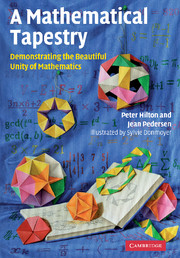
- Cited by 5
-
Cited byCrossref Citations
This Book has been cited by the following publications. This list is generated based on data provided by Crossref.
Pedersen, Jean and Tarnai, Tibor 2012. Mysterious Movable Models. The Mathematical Intelligencer, Vol. 34, Issue. 3, p. 62.
Bekes, Robert Pedersen, Jean and Shao, Bin 2012. Mad Tea Party Cyclic Partitions. The College Mathematics Journal, Vol. 43, Issue. 1, p. 25.
Wassell, Stephen R. and Benito, Samantha 2012. Edge-Length Ratios Between Dual Platonic Solids: A Surprisingly New Result Involving the Golden Ratio. The Fibonacci Quarterly, Vol. 50, Issue. 2, p. 144.
Gerdes, Paulus 2015. African Dance Rattles and Plaiting Polyhedra: A Journey. The Mathematical Intelligencer, Vol. 37, Issue. 2, p. 52.
Coniglio, Marcelo E Esteva, Francesc Flaminio, Tommaso and Godo, Lluís 2022. On the expressive power of Łukasiewicz square operator. Journal of Logic and Computation, Vol. 32, Issue. 4, p. 767.
- Publisher:
- Cambridge University Press
- Online publication date:
- November 2010
- Print publication year:
- 2010
- Online ISBN:
- 9780511777004
- Subjects:
- Mathematics (general), Mathematics


